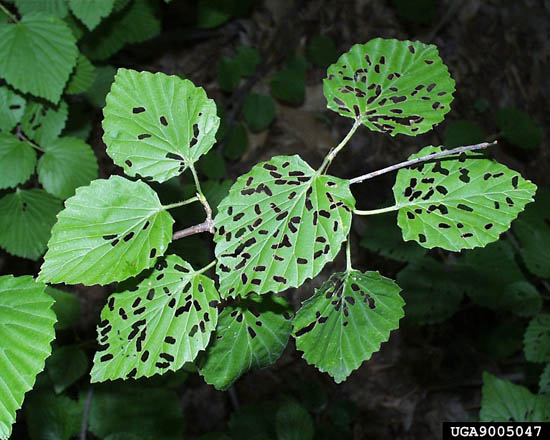Issue 7, June 10, 2013
Invasive Species Spotlight: Viburnum Leaf Beetle
Viburnum is one of America's most popular shrubs because of its beautiful flowers and wildlife attracting berries. However, this pretty plant is being threatened by the invasive Viburnum Leaf Beetle (Pyrrhalta viburni), a native of Europe that has been moved to North America on infected viburnums. It is now established in several states in the northeast and has now been found in several Midwestern states.
Viburnum leaf beetles overwinter as eggs on twigs of the host plant. Feeding is limited to species of viburnum. The viburnum leaf beetles have a preference for viburnums with little hair (pubescence) on the foliage, including the European cranberrybush viburnum, arrowwood virburnum, and American cranberrybush viburnum. They also feed on wayferingtree viburnum, Rafinisque viburnum, mapleleaf viburnum, nannyberry viburnum, and Sargent viburnum. There are several resistant varieties, including Koreanspice viburnum, Burkwood viburnum, doublefile viburnum, Judd viburnum, lanatanaphyllum viburnum, and leatherleaf viburnum.
In May, larvae hatch from the overwintered eggs and begin feeding on host plants. They are usually found feeding in groups. Between early and mid-June, larvae drop to the ground and pupate. They remain in the ground for about 10 days. Adult emergence generally occurs from mid- to late July.

Viburnum leaf beetle damage (photo courtesy of Paul Weston, Cornell University, Bugwood.org)
The adult beetle is small, ¼ to 3/8 of an inch long and is a golden brown color with sheen when in sunlight. The larvae are greenish- yellow and develop dark spots as they age. Adults will remain active until the first frost. Development from egg to adult takes eight to ten weeks.

Viburnum leaf beetle adults (photo courtesy of Paul Weston, Cornell University, Bugwood.org)
This pest has the potential to become a serious problem in nurseries and landscapes. Both the adult and larval stages of the viburnum leaf beetles can be severe defoliators. Larvae and adults feed on the leaves, defoliating between the midrib and larger veins. Heavy infestations can defoliate shrubs, cause dieback, and eventually kill the plants. It is the only pest known to skeletonize viburnum leaves. In late summer and fall, females will begin laying eggs. They chew holes in the bark of twigs to deposit eggs and then cover them with excrement and fragments of chewed bark. A female can lay up to 500 eggs.
The most effective management strategy (for small plantings) is to prune out and destroy infested twigs. This is best accomplished after egg-laying in the fall and before hatch occurs in the spring.
The Viburnum Leaf Beetle has only been confirmed in Cook and DuPage counties in Illinois. If your viburnum plants are showing signs of defoliation, please keep your eyes open for larvae now or Viburnum Leaf Beetle adults in the next few weeks. Residents are urged to report suspected infestations. If you see this pest or have questions, please contact or Kelly Estes at the Illinois Natural History Survey - Cooperative Agricultural Pest Survey kcook8@illinois.edu. (Kelly Estes)
Author:
Kelly Estes